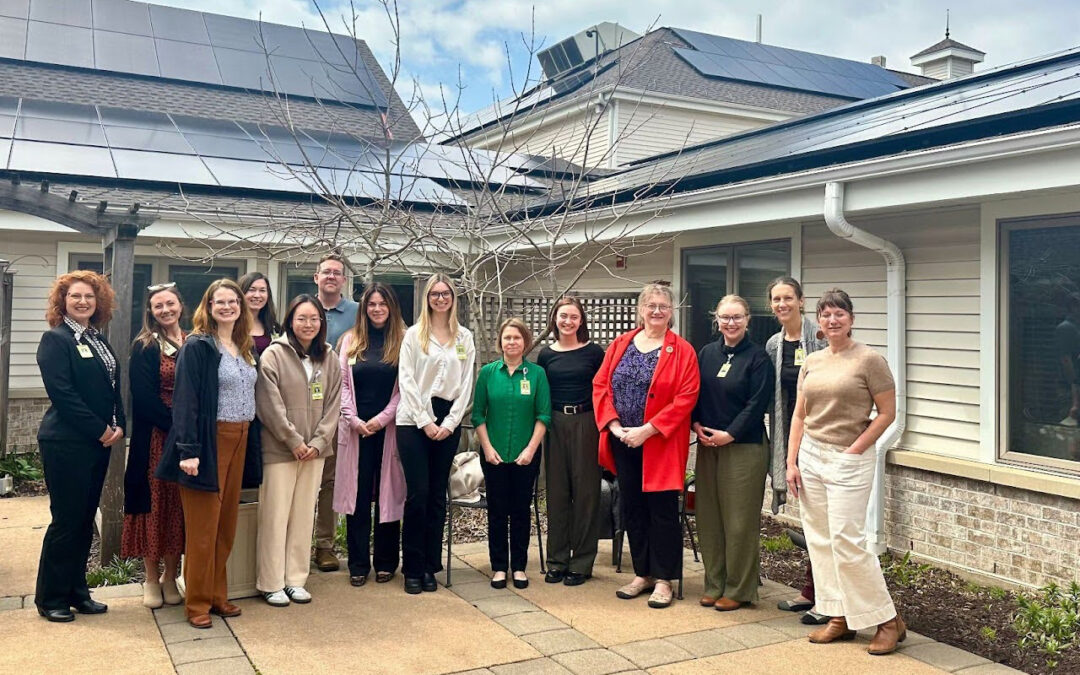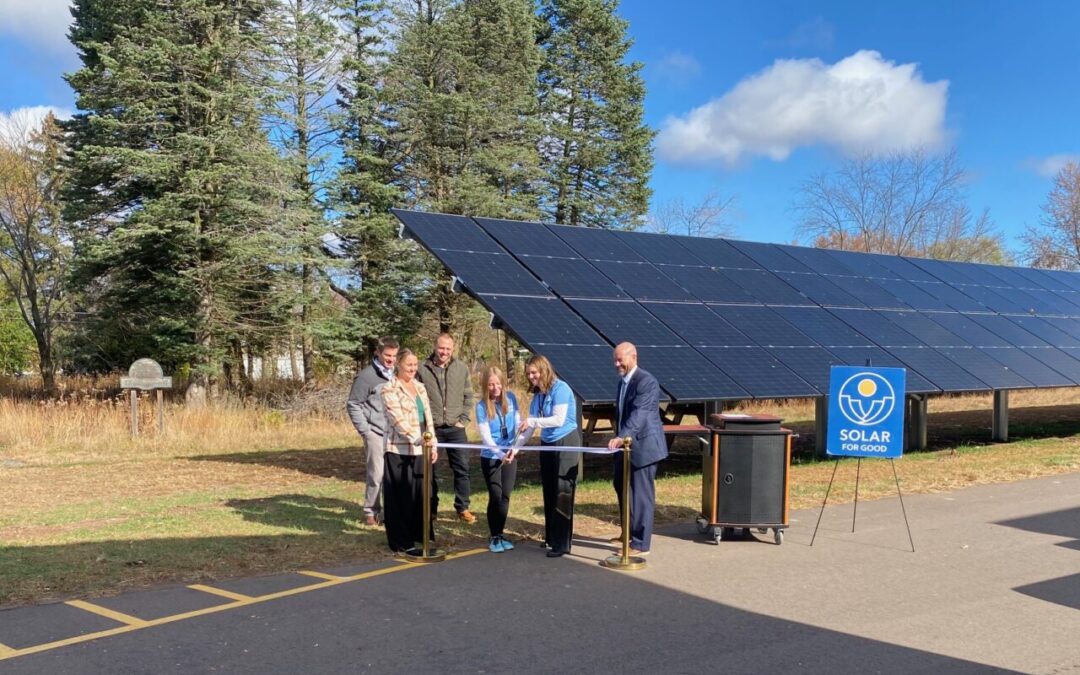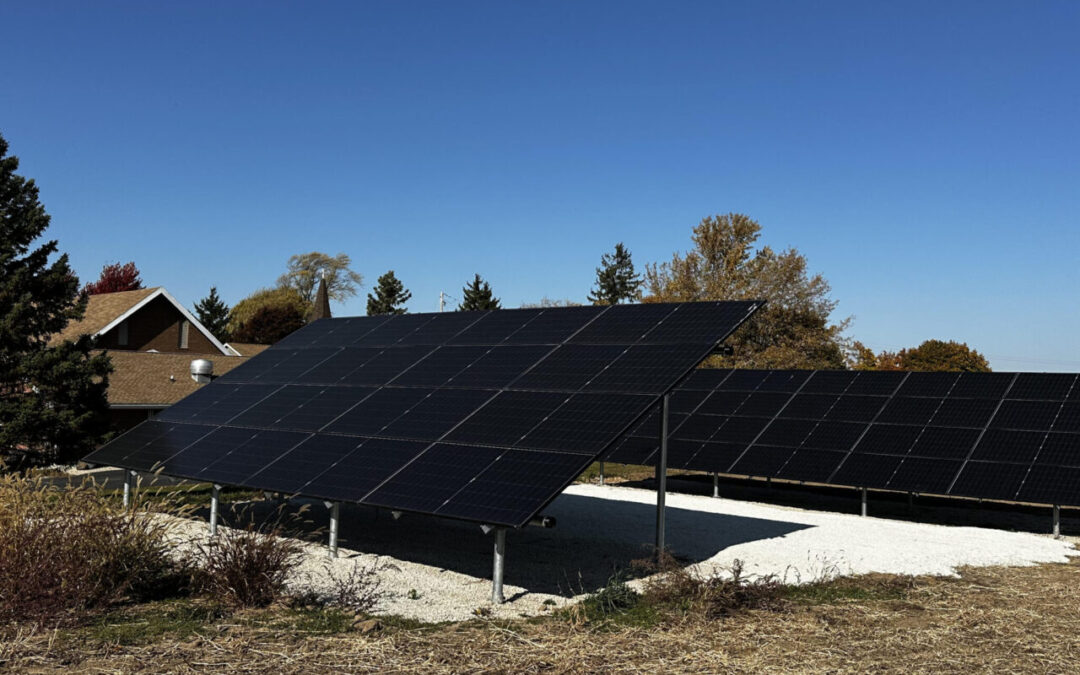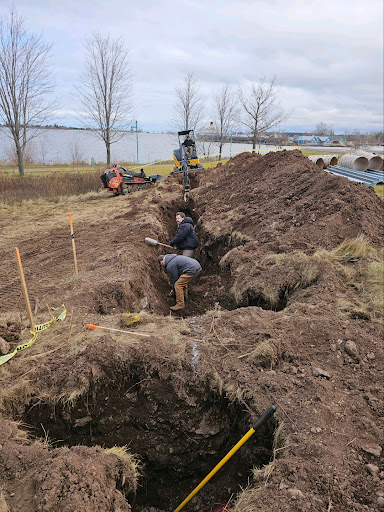
by Tiana Snyder | Apr 28, 2025 | Solar, Solar for Good
On Earth Day 2025, Agrace, a community-based healthcare organization dedicated to providing personalized care and support to individuals facing serious health challenges, celebrated a significant milestone in its commitment to sustainability. Agrace unveiled its 510-kilowatt solar array, symbolizing its dedication to environmental stewardship and its goal of achieving carbon neutrality by 2025. This achievement was made possible through Agrace’s partnership with RENEW Wisconsin and the Couillard Solar Foundation’s Solar for Good program and Full Spectrum Solar.
The unveiling event brought together key interested parties, including Jackie Harrison-Jewell, Executive Director of the Couillard Solar Foundation, Jamie Moen, Agrace’s Chief Operating Officer, and representatives from RENEW Wisconsin. The occasion marked the launch of the solar system and highlighted Agrace’s ongoing commitment to environmental responsibility, demonstrating how clean energy solutions can benefit both the environment and the community.
For more than 45 years, Agrace has been at the forefront of providing compassionate care across Southcentral Wisconsin. Its mission to help people live better during treatment for serious illness, care for elderly loved ones, and support individuals after a loss has always been central to the organization’s purpose. In 2021, Agrace launched a strategic initiative to better understand its environmental impact and develop a plan to reduce its emissions, which led to the decision to focus on sustainability and reducing its carbon footprint.
The healthcare sector represents a significant opportunity for adopting clean energy solutions like solar. Transitioning to renewable energy not only addresses greenhouse gas emissions on a large scale but also fosters energy resilience, allowing healthcare facilities to continue effectively caring for patients, even during disruptions caused by severe weather. Agrace’s commitment to sustainability sets an inspiring example, demonstrating how strategic actions can lead to both environmental and operational benefits.
Agrace’s first major step in its journey toward carbon neutrality was the installation of a 510-kilowatt solar system on the rooftop of its Madison facility. This system, which went live on August 26, 2024, has the capacity to power more than 60 homes and is expected to offset 20.84% of the facility’s electricity needs. The solar array is part of a broader strategy that includes energy conservation efforts, retro-commissioning of existing equipment, and the purchase of green power and carbon offsets.
The Solar for Good grant program played a vital role in supporting Agrace’s renewable energy efforts. The Solar for Good program helps nonprofit organizations, like Agrace, reduce energy costs and advance their mission. Thanks to a $20,000 award from Solar for Good in the Fall of 2023, Agrace was able to fund this transformative solar array. Agrace also leveraged additional funding sources, including Wisconsin’s Focus on Energy Program and Direct Pay incentives through the Inflation Reduction Act.
Full Spectrum Solar, the firm behind the installation, was instrumental in bringing Agrace’s clean energy goal to life. The team worked closely with Agrace to ensure the project was executed smoothly, providing valuable guidance on system performance and capacity. The solar array is now visible from various courtyards throughout the facility, allowing both staff and residents to benefit from the renewable energy.
Beyond reducing Agrace’s utility bills, the solar array plays a vital role in reducing the organization’s reliance on traditional energy sources. By producing its own renewable energy, Agrace is able to direct energy savings into vital programs such as Age at Home, Supportive Care, Hospice Care, and Grief Support, all of which serve the local community. Agrace plans to further its sustainability efforts by encouraging staff and residents to adopt energy-saving habits and exploring additional energy-efficient technologies like electric vehicle charging stations, battery storage, and heat pumps.
Agrace’s work serves as a powerful reminder of the positive impact that small actions, like transitioning to solar energy, can have on both the environment and the community. Through its partnership with Solar for Good to transition to solar, Agrace is not only committing to clean energy but also setting an example for others to follow. By continuing to invest in renewable energy and energy efficiency, Agrace is ensuring that its critical services will continue supporting the health and well-being of the people of Wisconsin while also making a lasting positive impact on the planet.

by Tiana Snyder | Apr 25, 2025 | Solar, Solar for Good
On Tuesday, April 15, 2025, the Richard I. Bong Veterans Historical Center marked an inspiring milestone in its ongoing mission to honor veterans with the installation of a new 20-kilowatt solar system. This sunny addition is not just a technological upgrade; it symbolizes the center’s commitment to creating a sustainable future while preserving the stories and legacy of the brave community members who have served the United States. The event, attended by community leaders, city officials, and distinguished guests, highlighted the importance of integrating sustainability into institutions that hold deep historical value.
Named after Major Richard Ira Bong, the United States’ Ace of Aces during World War II, the Bong Center has been a space for reflection, remembrance, and education. Its mission is to honor veterans by sharing their stories, preserving their experiences, and educating the public about the sacrifices made by those who served. Since its opening, the center has collected over 800 personal stories from veterans and serves as a vital resource for the Superior community. Iconic exhibits, including a fully functional P-38 aircraft, help bring Major Richard Ira Bong’s heroic feats to life, while the Wall of Honor memorializes the names and stories of veterans throughout U.S. history.
With the installation of the new solar system, the Bong Center has made a significant technological advancement, combining its dedication to honoring history with its responsibility to protect the environment. This solar project is the first phase of a broader initiative to create a sustainable future for the center and its visitors. The 20-kilowatt system, expected to provide significant energy savings, was made possible through the generosity of RENEW Wisconsin and the Couillard Solar Foundation’s Solar for Good program, along with an anonymous donor. These financial resources helped cover installation costs and materials, ensuring that the project moved forward without financial strain.
The solar system’s value extends beyond serving as an energy source; it’s a symbol of how historical institutions can adapt to meet modern challenges. Just as Major Richard Ira Bong’s legacy continues to inspire, the Bong Center’s embrace of clean, renewable energy is a powerful reminder that we can honor the past while also protecting our planet. The energy produced by the solar panels will help power the center’s operations, reducing its reliance on traditional energy sources and lowering its environmental impact.
Installing this solar array was not without its challenges, however. Initially, the plan was to place the solar panels on the roof, but logistical concerns related to wind conditions near Lake Superior led to a pivot. The new solution was to install a ground-mounted system, which was approved by the City of Superior in June of 2023. During installation, Carlson Electric uncovered mounds of concrete and blacktop beneath the ground, requiring quick thinking and teamwork to ensure a winter installation. Yet, through the perseverance and collaboration of the Bong Center, Solar for Good, and the donor community, these hurdles were cleared, and the project stayed on track.
By January 29, 2025, the system was live, and the Bong Center began generating its own clean, renewable energy. This success highlights the importance of community involvement in making such meaningful initiatives possible. Executive Director John Gidley, alongside energy advocate John Trochinski and the team at Carlson Electric, played a pivotal role in ensuring the project’s success. Their hard work proved that with determination and collaboration, any challenge can be overcome.
The Bong Center envisions expanding its energy capacity in the coming years, with the goal of providing at least 80% of its electrical needs through solar energy. This forward-thinking approach will further reduce the center’s reliance on traditional energy sources and continue to demonstrate its commitment to sustainability and innovation. The installation of the solar system at the Richard I. Bong Center is a perfect blend of history and progress; a commitment to honoring veterans’ legacies while supporting eco-friendly innovations.
The solar array, now powering the center’s daily operations, is more than just a renewable energy source. It’s a tribute to the perseverance, ingenuity, and dedication of those who have served our country. It’s a reminder that the work we do today, from honoring our heroes to adopting cleaner energy solutions, helps ensure that the stories of the past will continue to inspire generations to come. By integrating solar energy into its mission, the Bong Center is leading the way for other historical institutions to balance preservation with progress and show that a sustainable future is possible when we work together for the greater good.

by Tiana Snyder | Jan 17, 2025 | Solar, Solar for Good
On Monday, January 13, Gilda’s Club Madison invited representatives from RENEW Wisconsin, Couillard Solar Foundation, Only in Wisconsin, Glow Solar, and their members to join in the celebration of a monumental achievement. Gilda’s Club with the help of its supporters installed a solar array that will offset 100% of its electrical usage.
Gilda’s Club was established in 1991 to honor the late comedian, Gilda Radner, with a mission to uplift and strengthen people who are impacted by cancer by providing support, fostering compassionate communities, and breaking down barriers to care. In 2008, Gilda’s Club Madison opened its doors to the Wisconsin community, becoming one of many worldwide affiliates. Over the years, the organization has been a foundational resource for its members in providing free counseling services, social events such as a brunch club, field trips across Dane County, equestrian therapy, and more.
Glow Solar installed a 31.4-kilowatt solar system. John Reinders, President of Glow Solar shared, “At Glow Solar, we love working with non-profits to design and implement renewable energy solutions that fit their individual goals. In the case of Gilda’s Club, we helped them design and install a system that will meet their goals to offset 100% of their annual electric usage, look great on their building, and continue to serve their clients without worrying about escalating energy costs. The grants from Focus on Energy and Solar for Good help make it a great time for non-profits like Gilda’s Club to pursue their renewable energy goals.”
For many, going solar is a viable opportunity to continue helping their members thrive without having to reduce support for their mission. With the availability of direct pay incentives for nonprofits, organizations like Gilda’s Club Madison are able to enhance their sustainability initiatives and focus more funding toward their mission by going solar. In addition to taking advantage of federal and state funding, the solar project also received support from BIOFerm, Only in Wisconsin (the charitable arm of New Glarus Brewing Company), and Solar for Good, a program funded and founded by the Couillard Solar Foundation and managed by RENEW Wisconsin.
In reflecting on the long-term impact solar will have on their community, the CEO of Gilda’s Club Madison, Lannia Stenz shared, “We are thrilled to install solar panels at Gilda’s Club Madison, taking a meaningful step toward sustainability and reducing our environmental footprint! This project is a testament to the power of community—thank you to Solar for Good and everyone who made this possible. Your support not only brightens our future but also ensures that Gilda’s Club can continue offering vital resources to those facing cancer, free of charge, for many years to come.”
Beyond solar serving as a responsible financial decision, it’s also an investment in the health and sustainability of Wisconsin communities. In the case of Gilda’s Club Madison, their decision to go solar contributes to cleaner air by reducing carcinogenic air pollutants and offers a promise to their members that they can continue providing support to families and individuals living with cancer. This celebration serves as an important reminder for Wisconsin that when mission-driven organizations, residents, and businesses collectively make an investment in clean energy, they are also making a direct investment into their communities.

by Tiana Snyder | Nov 21, 2024 | Press Release, RENEW Wisconsin, Solar, Solar for Good
The Solar for Good grant program has awarded over $220,000 in grants and solar panel donations to Wisconsin nonprofit organizations for the Fall 2024 grant round. The 14 nonprofits will install 16 projects for a total of 1,000 kilowatts of solar electricity, leading to more than $2.3 million in renewable energy investments in Wisconsin.
The following organizations have been awarded Fall 2024 Solar for Good grants to install new solar energy
systems:
CAP Services, Inc. – community service, Stevens Point
COULEECAP, Inc. Hillcrest Manor – affordable housing, Ontario
COULEECAP, Inc. REACH – community service, La Crosse
EAGLE School of Madison – education, Fitchburg
Family and Children’s Center – community service, La Crosse
Family Services of Southern Wisconsin and Northern Illinois, Inc. – community service, Beloit
Holy Spirit Parish – house of worship, Stevens Point
Hunger Task Force – community service, West Milwaukee
Ozaukee Food Alliance – community service, Saukville
Recreation and Fitness Resources Center – recreation, Bayfield
Union Congregational United Church of Christ – house of worship, Green Bay
VIA CDC – affordable housing, Milwaukee
West Central Wisconsin Community Action Agency – affordable housing, Hudson
*One organization has asked to remain anonymous.
The grant recipients from the Fall 2024 grant round are a diverse range of organizations, representing affordable housing organizations, schools, and houses of worship. Each facility’s solar project will have a significant impact on their budgets, and will allow them to focus more funds on their missions. Holy Spirit Parish will install 90 panels atop their place of worship in Stevens Point, Family Services of Southern Wisconsin will incorporate 69.6kW of solar to their rooftop, and VIA CDC will install solar systems of 5.33 kilowatts on three housing projects in Milwaukee.
“We are thrilled and deeply grateful for this opportunity through RENEW Wisconsin’s Solar for Good initiative. This support allows us to further our mission with VIA’s Turnkey Program and new construction housing, making a lasting, positive impact on our community through sustainable energy,” said JoAnna Bautch, Executive Director at VIA CDC.
Similarly, the Solar for Good grant will allow Family Services of Southern Wisconsin and Northern Illinois to continue serving families in need by reducing operational costs and allocating more funding to programming.
“This funding has allowed us to equip our Next Steps Family Resilience Center with solar power that will be vital to the long-term sustainability of this programming for unhoused parents with young children while also contributing to a healthier community overall,” said Kelsey M. Hood-Christenson, President and CEO, of Family & Children’s Services of Southern Wisconsin and Northern Illinois.
Since 2017, Solar for Good has awarded grants to over 200 nonprofits across Wisconsin, leading to more than $29.4 million of renewable energy investments in the state. Collectively, Solar for Good grant recipients will go on to install more than 10 megawatts of solar energy.
“We are most grateful to the Couillard Solar Foundation for awarding us half the solar panels we need for installation of our solar array at Holy Spirit Parish in Stevens Point,” said Susan Zach Burns, Solar Project Lead of Holy Spirit Parish. “By reducing our reliance on fossil fuel and turning to solar for a good share of our energy needs, we are joining with you and others to address greenhouse gas emissions and to care for our common home, our beautiful Earth.”
“Our congregation has been energized literally and figuratively by our solar installation and our grant from Solar for Good. Not only will our installation reduce the carbon footprint of our church, it has inspired our members to invest in solar and other climate-friendly initiatives as well,” said Reverand Bridget Flad Daniels, Union Congregational UCC of Green Bay.
Through the assistance from Solar for Good grants, these 16 installations will accelerate Wisconsin’s transition to solar energy, facilitating the expansion of environmental stewardship and energy savings. As Solar for Good looks ahead to future grant rounds, the program will remain committed to supporting nonprofits and houses of worship across the state of Wisconsin by supporting organizations in their efforts to contribute to a positive environmental impact, enhance economic advancement in Wisconsin, and strengthen their ability to aid the communities they serve.

by Tiana Snyder | Nov 11, 2024 | Solar, Solar for Good
On Friday, November 1, Cooperative Education Services Agency 10 (CESA 10) celebrated the completion of its new 124.2-kilowatt solar array during their ribbon-cutting ceremony. Member school districts, Solar Connection, the Green Team, Couillard Solar Foundation, and RENEW Wisconsin joined the event to celebrate this significant milestone. The organization’s commitment to energy efficiency and sustainability in education sets a strong example for school districts and surrounding communities on the benefits of renewable energy and how they can go solar too.
Solar Connection installed a ground-mount solar system consisting of 235 solar panels with 115 panels secured through the Solar for Good grant program. The solar system is set to offset the organization’s electrical consumption by approximately 75%. The successful installation of this project was made possible through dedicated support from the CESA 10 team and support from funding sources. Additionally, the team took advantage of federal and state incentives including the Inflation Reduction Act and Focus on Energy.
Serving 29 school districts and more than 36,000 students, CESA 10 plays a crucial role in offering educational programs and services, ranging from college readiness programs to educational technology and facilities management. Choosing to go solar reflects a key part of their mission in helping schools reduce operational costs so that greater resources can be allocated to enriching the educational experience of students. Its new solar array will not only reduce its own operational costs, but also demonstrate to educators, students, and the broader community the long-term benefits of clean renewable energy.
Going solar is the latest step in CESA 10’s broader sustainability initiatives, but their journey into greater energy efficiency began several years ago. In recent years, they have also undertaken several energy efficiency upgrades including adding LED lighting, improving installation, and replacing roofs of its facilities. Each efficiency upgrade adds up to have a significant positive impact, including lower operating costs and a smaller carbon footprint. With the solar panels recently commissioned, the organization consistently plans to work towards further energy improvements.
Through their efforts, CESA 10 is not only benefiting their own facility but also contributing to a future where solar energy plays a larger role in Wisconsin’s schools. As a leader in showcasing the tools accessible to educators, this project encourages others to consider how they can explore clean energy solutions to enhance their efforts in serving students and having a positive environmental impact.

by Tiana Snyder | Oct 26, 2024 | Solar, Solar for Good
On October 20, 2024, Sugar Creek Lutheran Church opened its doors to welcome congregation members, nonprofit leaders, and representatives from other houses of worship to explore its new solar system. The new 19.6-kilowatt solar system is set to exceed the church’s current electrical needs by 14%. These savings will allow Sugar Creek Lutheran Church to continue supporting its congregation, provide scholarships to students pursuing higher education, and provide additional community programming.
The open house featured a tour of its new solar installation, a presentation provided by Solar Project Lead Ervin Schlepp, and materials that outline a step-by-step guide for how other community members and fellow nonprofits can switch to solar energy.
Established in 1849, Sugar Creek Lutheran Church has been a leader and innovator for the Elkhorn community by providing various programs, including a ‘food in backpacks’ meal service program for two schools, and scholarships for students to further their education. The church’s mission “to witness Christ’s love, presence and acceptance with and for all people” is the foundation of the work they do to ensure a positive well-being for the Elkhorn community.
As they approached their 175th anniversary, leadership of the church began to deeply consider how they could further impact the community while also excelling in care for the planet. The congregation’s strong connection to the rural land that the church is situated on drove the church’s desire to explore how Sugar Creek Lutheran Church could enhance its energy efficiency. The solar project team identified incentives including the Inflation Reduction Act 30% tax credit and Focus on Energy, which could help make the transition to solar energy a practical and feasible option. Grant programs further assisted Sugar Creek Lutheran Church in transitioning to solar by greatly reducing the upfront costs of installing the array.
Sugar Creek Lutheran Church contracted a local solar installer company, Adam’s Electric, to install 36 panels. Generous donations from the congregation, in addition to significant grants from the Couillard Solar Foundation and Hammond Climate Solutions Foundation facilitated the development of this project. Through the Solar for Good initiative, Couillard Solar Foundation provided half of the panels needed for the project, and the Moonshot Solar Program funded by Hammond Climate Solutions Foundation contributed $25,000 in grants. By making this project possible through donations from the congregation, Couillard Solar Foundation, and Hammond Climate Solutions Foundation the church will operate on 100% clean energy.
“In our 175th year of life as a congregation and because of the generosity of our congregation we have the opportunity to provide for the electrical needs of Sugar Creek until we celebrate our 200th anniversary,” said Pastor Dick Inglett.
Sugar Creek Lutheran Church, and many other nonprofits across Wisconsin, lead by example within their communities by demonstrating how others can benefit through the power of solar by increasing savings and creating healthier communities. Well over 200 nonprofits across the state serve as ambassadors, encouraging communities to embrace clean and renewable energy through the Solar for Good grant program. Each organization reduces its own costs and inspires local residents to consider the positive impact of solar energy, creating a culture of sustainability and well-being in Wisconsin.









